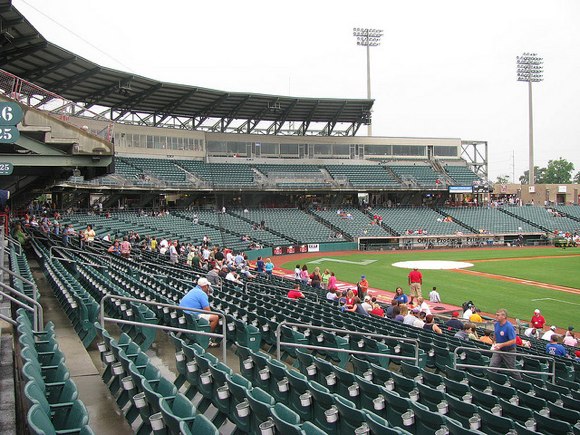
What do the NBA’s New Orleans Hornets, Utah Jazz and Los Angeles Lakers have in common? Each team’s nickname predates its current city. The Hornets came from Charlotte, the Jazz moved from New Orleans, and the Lakers once played in Minneapolis. So it is with the Zephyrs, originally the Denver Zephyrs, who moved to New Orleans in 1993 when Denver received a Major League franchise of its own.
FAST FACTS
Opened: April 11, 1997
Capacity: 11,000 (10,000 seats + The Levee)
Dimensions: 330L, 400C, 330R
Surface: Grass
Owner: State of Louisiana
Website: zephyrsbaseball.com
Online Ticket Sales: Yes
Ticket Prices (2012): Lower Level Box, $12 day of the game, $10 beforehand; Upper Level, $9 day of the game, $8 beforehand; The Levee (center field berm), $6.
Phone: 504/734-5155
League: Triple-A Pacific Coast League
Parent: Miami Marlins
Address: 6000 Airline Drive, Metairie, LA 70003
Directions: From the team website, driving from downtown New Orleans: “Take I-10 West to Clearview Parkway South exit, turn right at Airline Drive (Hwy 61) and head west (right); stadium is on the left in three miles. OR Take Tulane Avenue and it turns into Airline Drive (Hwy 61) just after you pass under I-10. Continue on Airline Drive for about eight miles and just after the Transcontinental Drive intersection, you’ll see the stadium on the left.”
Parking: $5 per car, $10 for a bus (or oversized vehicle).
Written By: Jesse Goldberg-Strassler (October 2012)
Zephyr Field sits in Metairie, Louisiana (the birthplace of Ellen DeGeneres), an unincorporated area located to the west of the Big Easy. A zephyr is a gentle breeze; in other words, nothing like the winds stirred up by Hurricane Katrina as it ravaged New Orleans and Mississippi River Delta in 2005. Caught in the thick of things, Zephyr Field played a significant role in New Orleans’ recovery, used by FEMA and the Louisiana Army National Guard to aid in rescue work in Katrina’s aftermath. In the offseason, a $21 million grant from the state was put into rebuilding. the ballpark’s damaged scoreboard, sound system, roof and stadium lights. The challenge was met successfully. On April 6, a stirring collection of 11,006 fans welcomed the Zephyrs back to town, the first New Orleans area pro sports team to resume permanent play following Katrina.
When the Zephyrs came totown, the Milwaukee Brewer-affiliated team initially put down roots in Privateer Park, home of the University of New Orleans baseball team, before partnering with the Houston Astros and moving into their gorgeous new facility in Metairie in 1997.
Since opening its gates, Zephyr Field has been used for games outside of the minor league world, including the short-lived New Orleans Storm soccer team (1998 and 1999), the Sun Belt Conference Tournament (1998 and 1999), the Conference USA Tournament (2001), a Super Regional pitting local rivals Tulane and LSU (2001), and the Class 5A Louisiana High School Athletic Association Baseball Tournament (2004 and 2005). The ballpark can also be seen in such Hollywood offerings as “Mr. 3000” (2004) and “Failure to Launch” (2006).
The Zephyrs said farewell to the Astros following 2004, signing on with the Washington Nationals through 2006, the New York Mets through 2008, and forming their present partnership with the Miami Marlins in the 2008-2009 offseason. No matter the parent club, Zephyr Field is regarded as a pitcher-friendly park in the notoriously hitter-dominated Pacific Coast League. In 2012, New Orleans batted .251 with 63 roundtrippers at home compared to .277 with 90 home runs on the road. The Zephyrs’ hurlers weren’t complaining, posting a 40-28 record with a 3.31 ERA at Zephyr Field, far better than the club’s 33-39, 4.64 mark away from New Orleans.
Zephyr Field features two different levels of seating, stretching around home plate and down each line, with — interestingly — different prices for tickets depending upon whether a fan purchases tickets in advance or on the day of the game. The lowe- level box seats directly behind home plate and the dugouts, for example, run $10 apiece if bought with foresight, though they cost $12 on the day in question. The only ticket prices that do not change are located in The Levee, the center field lawn area that is located at the highest point in Metairie.
Image from flickr.com, from nola.agent.
RELATED STORIES: Team ballpark bio on MiLB.com
—-
Share your news with the baseball community. Send it to us at editors@augustpublications.com.
Are you a subscriber to the weekly Ballpark Digest newsletter? You can sign up for a free subscription at the Newsletter Signup Page.
Join Ballpark Digest on Facebook and on Twitter!
Follow Ballpark Digest on Google + and add us to your circles!
